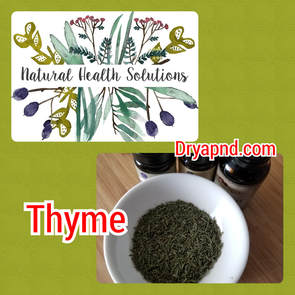
Haha, get it! What Thyme is it. Yes, I did make a corny joke and laughed at it. Just my cheesy humor. Well, here is another herb that no one thinks about when it comes to medicinal use. Yes, it’s Thyme, I give you some information about this herb…lol. I did it again. I usually think of spaghetti or Italian seasoning when I think of Thyme but it has been used traditionally in medicine for upper respiratory issues. I know when I first used it for a sore throat and cough I was surprised it worked. Here is a summary on this herb. Maybe this will inspire you to start studying herbs in the food you eat. As always, eat real food and stay healthy.
Common Name: Common Thyme
Botanical Name: Thymus vulgaris
Parts of the plant used: leaves, flowers and oil
Main Constituents: Essential Oils: thymol and carvacrol; Other constituents: terpenoids, glycosides of phenolic monoterpenoids; eugenol and aliphatic alcohols; the flavonoids thymonin, cirsilineol, and 8-methoxycirsilineol; biphenyl compounds of monoterpenoid origin; caffeic and rosmarinic acids; and saponins, tannins, labiatic acid, ursolic acid, and oleanolic acid. Thyme also contains apigenin, luteolin, and 6-hydroxyluteolin glycosides, as well as di-, tri-, and tetramethoxylated flavones, which are all substituted in the 6-position (5,4′-dihydroxy-6,7,3′-trimethoxyflavone and its 8-methoxylated derivative, 5,6,4′-trihydroxy-7,8,3′-trimethoxyflavone, 5,4′-dihydroxy-6,7,8-trimethoxyflavone, 5,4′-dihydroxy-6,7-dimethoxyflavone)
Therapeutic Actions: carminative, antibiotic, anthelmintic, astringent, expectorant, and antitussive
When would you use this plant: heartburn, gastritis, asthma, laryngitis, pertussis, bronchitis, whooping cough, upper respiratory inflammation, stomatitis, and halitosis.
Folklore, myth, and tradition: People would rub this herb in their eyes because they believed you would see fairies. It was used for embalming.
Personal Experience: I use the essential oil in a steam inhalation when I have a sore throat or a cough.
Reference:
